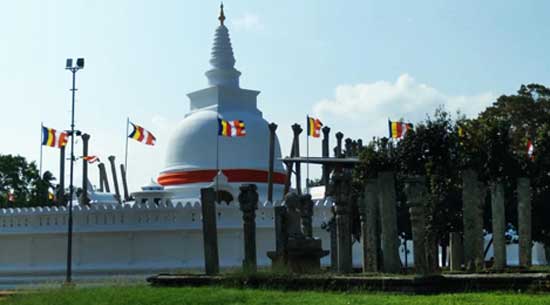Other stupas maybe grander but Thuparamaya stands tall
The Thuparamaya in Anuradhapura was the first stupa built in the country around 300 B.C, in the reign of King Devanampiyatissa. Since then, grander stupas have been erected in Anuradhapura and across the country, but the Thuparamaya or Thuparama Dagaba remains one of the most revered places of worship for Buddhists, aesthetically pleasing and a testimony to the skills of ancient builders.
It was on the request of Arahat Mahinda Thera that King Devanampiyatissa undertook the building of the Thuparamaya to enshrine the right collar bone relic of Lord Buddha.
There are several versions of the story of how the construction of the Thuparamaya was initiated with Sakka Deva, the chief of gods, also playing a part in obtaining the collar bone relic to be enshrined in it.

Thuparamaya: Decked for Vesak this week. Pic by B.G.Chaturanga
Brahmchari Walisinha Harishchandra, in his book, The Sacred City of Anuradhapura, has drawn from ancient texts to give a detailed account of the conversation between Arahat Mahinda Thera and the King, in which the Thera explains the symbolic importance for a relic of Lord Buddha being brought to the island of Lanka, which had shortly before embraced Buddhism as the state religion under the patronage of King Devanampiyatissa.
“Great king! our divine Teacher the supreme Buddha has long been out of our sight; we are sojourning here without our Master. In this land, O Ruler of men! we have no object to which offerings can be made,” says Arahat Mahinda Thera to the King. He replies, “Lord, did not Your Lordship tell me that our supreme Buddha had attained Nirvana?”
To the King’s query, Arahat Mahinda Thera explains; thus, “Whenever His Sacred Relics are seen the Great Master Himself is seen,” after which the King understands he is required to build a Thupa to enshrine relics. ‘I will do it; may Your Lordship please procure the Relics,” the King replies. Thus the construction of the stupa or dagaba to house the relics of Lord Buddha is initiated.
A.H. Longhurst, Archaeological Commissioner of Ceylon in his book, The Story of the Stupa, explains that the chief purpose for which stupas were erected by the Buddhists was to serve as monuments enclosing the relics of Lord Buddha, or of Buddhist saints (arahats) which were placed in a reliquary enclosed in a stone coffer, over which the stupa was built. Some however contained no relics but were merely commemorative of important events in the Buddha’s life.

The holy Thuparama dagoba, in which the collar bone of the Buddha is buried, Anuradhapura, Ceylon (Library of Congress USA, 1907)
“When they contained relics, the shrine was known as a Dhatugarbha (Pali, Datugabho; Sinhala Dagaba) and as most stupas were erected over relics (dhatu) the whole structure came to be called a Dagaba.
To obtain a relic of Lord Buddha to be enshrined in the Thuparamaya, Arahat Mahinda Thera despatched Sumana Samanera, the son of Princess Sanghamitta, to the court of King Asoka of India. Sanghamitta Theri was the daughter of King Asoka and had become a theri on her father’s request and had accompanied Mahinda Thera to Lanka. Sumana Samanera arrived in the court of Emperor Asoka with the following message. “Great King, your ally, the King of Lanka, converted to Buddhism, is anxious to build a Dagaba.You possess many corporeal Relics of the Lord; bestow some of those Relics and the Bowl used by the Buddha.”
Thus, the Collar-bone Relic of Lord Buddha was brought to the island and received by King Devanampiyatissa in a casket, placed on the back of the state elephant that was caparisoned for the purpose and taken in procession.
“It (the procession) started from the Sacred Garden, entering the political City by its eastern gate, and passing through it by the southern gate, returned to the Sacred City and halted at the spot where the Thuparama Dagaba was subsequently built,” writes Brahmchari Harishchandra.
Arahat Mahinda Thera too joined the procession with his large retinue of monks and said that the Relic should be deposited on a summit as high as the back of the state elephant. The King thus ordered the vast assembly of men present there to bring lumps of clay from the Abhaya Wewa (now known as Basawakkulama Wewa) and heap it up to the elephant’s height. After it was finished, the Relic casket was placed on top of the mound.
D.T. Devendra who published an article on the Thuparama in the Journal of the Ceylon Branch of the Royal Asiatic Society (1966) explains how it was decided what shape the stupa being erected should take. When the relics had been duly obtained from Emperor Asoka and everything was ready for the actual building, King Devanampiyatissa asked Arahat Mahinda Thera in what form the thupa should be raised.
“Great King in the shape of a heap of paddy,” the Thera replied and hence it was decided the Thuparamaya would be thus designed.
It is said that within a few weeks’ time the Dagaba was constructed, and the right collar-bone of the Lord Buddha was enshrined in the presence of the Theras, the King, the nobility and the populace, with great magnificence.
Throughout the centuries, the Thuparamaya has undergone several changes with successive Lankan monarchs who ruled from Anuradhapura enhancing it while keeping the original stupa intact. However, restoration work in the 18th century altered its shape. According to the District Secretariat of Anuradhapura, the renovation of the present stupa completed in 1862 completely changed the features of this most ancient stupa and today the Thuparamaya is shaped like a bell (Ghantakara) instead of the original paddy-heap (Dhanyakara) shape.
Many writers on the ancient cities of Ceylon have referred to the prominence the Thuparamaya retains even though it stands near larger and more majestic stupas in Anuradhapura.
Henry. W. Cave in his “Ruined Cities of Ceylon” says of the Thuparamaya. “This monument is, in itself, evidence of the remarkable skill of architect, builder and sculptor in Ceylon, at a period anterior to that of any existing monument in the mainland.”
In his ‘Brief account of Ceylon, L F. Liesching, who served in the Ceylon Civil Service (1861) says that among the dagobas about Anuradhapura, deserving of special notice, the first in point of antiquity is the Thuparamaya, a monument with classic stone pillars, with elegantly chiselled capitals, which surrounded it.
James Fergusson in his publication, ‘History of Indian and Eastern Architecture’ Vol. I (1910), also notes the importance of the Thuparamaya. “As contemporary with Ashoka, it belongs to the most interesting period of Buddhist history, and is older, or at least as old, as anything now existing on the continent of India and there is every reason to suppose it existed till 1842, as nearly as may be, in the form in which it was originally designed, having escaped alteration, and, what is more unusual in a Buddhist relic-shrine, having escaped augmentation.”
D.T. Devendra calls the Thuparamaya without question the most beautiful of Ceylon’s thupas with its aesthetic appeal greatly enhanced by the rows of graceful stone pillars which encircle it.
Today ruins of this complex cover over three acres in land. The Thuparamaya is provided with two compounds, the first being Salapatala Maluwa, the other is the extensive compound called Weli Maluwa which adjoins the former on all sides.
In close proximity to the Thuparamaya are the ruins of the old Dalada Maligawa which once housed the Sacred Tooth Relic of Lord Buddha. The stupa which holds the relics of Sanghamitta Theri, who along with Arahat Mahinda Thera, set off more than 2,200 years ago from Pataliputra (now in the Indian state of Bihar), to Anuradhapura in Sri Lanka bringing with them the teachings of the Enlightened One is also near by.
Centuries later, the teachings of Lord Buddha endure in the land miles away from the land of the birth of Siddhartha Gautama, with monuments such as the Thuparamaya testimony to this precious legacy.
Searching for an ideal partner? Find your soul mate on Hitad.lk, Sri Lanka's favourite marriage proposals page. With Hitad.lk matrimonial advertisements you have access to thousands of ads from potential suitors who are looking for someone just like you.


